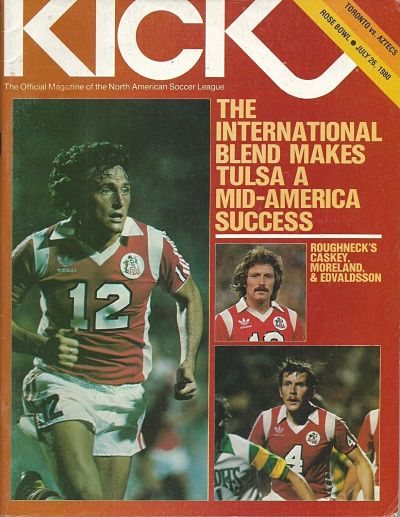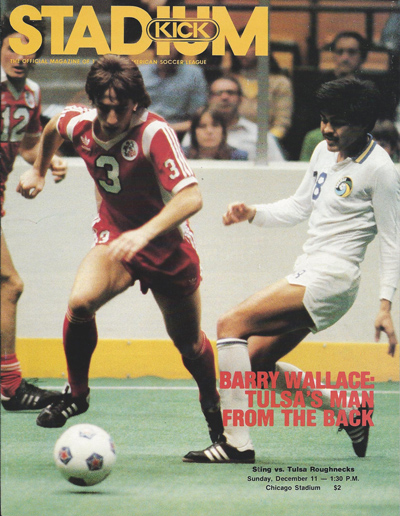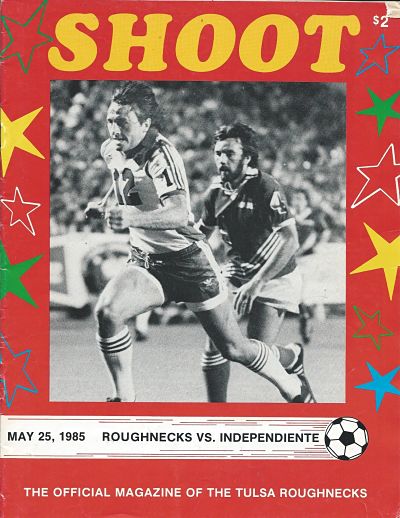North American Soccer League (1978-1984)
Independent Club (1985)
Tombstone
Born: November 15, 1977 – Team Hawaii relocates to Tulsa, OK1Chase, Al. “Pro Soccer in Islands Gone with Wind”. The Star-Bulletin (Honolulu, HI). November 16, 1977
Folded: August 31, 1984 (Roughnecks a
nnounce they will at conclusion of season on September 8th)2UNITED PRESS INTERNATIONAL. “Roughnecks bite the dust”. The Daily Times (Okmulgee, OK). September 1, 1984
Born Again: January 1985
Folded Again: July 17, 19853ASSOCIATED PRESS. “Tulsa Roughnecks suspend operations.” The Sun (Vancouver, British Columbia). July 18, 1985
First Game: April 1, 1978 (L 2-1 vs. Detroit Express)
Last Game: July 13, 1985 (W 4-3 vs. Minnesota Strikers – exhibition)
Soccer Bowl Champions: 1983
Stadia
Outdoor Soccer:
Skelly Stadium (41,000)41982 Official North American Soccer League Guide
Opened: 1930
Indoor Soccer:
Expo Square Pavilion (6,300)
Opened: 1932
Marketing
Team Colors: Red, White & Black51982 Official North American Soccer League Guide
Television:
- 1982: KJRH (Channel 2 – selected games)
Television Broadcasters:
- 1982: Chris Lincoln (play-by-play) & Jerry Webber (Color)
Radio:
- 1982-1983: KRMG (740 AM)
Radio Broadcasters:
- 1982: Chris Lincoln (play-by-play) & Bill Land (color)
Ownership
Owners:
- 1978-1980: Ward Lay, Tom Keeter, et al.
- 1980-1983: Rick Loewenherz, Carl Moore, Mike Kimbrel & Fred Williams
- 1984: Tulsa Cable, Inc. (Mark Savage)
Attendance
Tilting your mobile device may offer better viewing.
Outdoor Attendance:
Source: Kenn.com Attendance Project
Trophy Case
Soccer Bowl Most Valuable Player
- 1983: Njego Pesa
Background
The Tulsa Roughnecks set up shop in Oklahoma in late 1977 after the franchise failed to catch fire during earlier stops in San Antonio and Honolulu.
In addition to their summer exploits at Skelly Stadium, the Roughnecks also played several seasons of indoor soccer at Expo Square Pavilion during the winter time as part of the NASL’s on-again/off-again flirtation with the indoor game.
Soccer Bowl ’83
The Roughnecks’ sixth outdoor season in 1983 did not begin with much promise. NASL membership was down to 12 clubs, after fielding 24 just three seasons earlier in 1980. Tulsa entered the campaign with the league’s lowest payroll at $700,000 and got off to a slow 2-8 start.6Phillips, Randy. “Tulsa captures Soccer Bowl with dull victory over Blizzard”. The Gazette (Montreal, QC). October 3, 1983But coach Terry Hennessey’s squad got hot and won 19 of their final 25 matches through the regular season and playoffs.
The final was scheduled for October 1st, 1983 in Vancouver. The game would be the last in the single-leg, neutral site “Soccer Bowl” format that the NASL introduced in 1975, drawing obvious inspiration from the NFL’s Super Bowl. Howard Samuels, the business executive installed as NASL President in 1982 to turn around the faltering league, was a harsh critic of the format, terming the 1981 and 1982 Soccer Bowls “disasters”.7Vecsey, George. “Sports Of The Times; The Soccer Bowl Not A Super bowl”. The Times (New York, NY). September 19, 1982 And Samuels would not be able to resist meddling in the 1983 championship game, to the Roughnecks’ great benefit.
Tulsa advanced the final by eliminating the Montreal Manic in a three-leg semi-final. In the third match of the semi-final series, Roughnecks’ leading scorer Ron Futcher drew his third yellow card of the playoffs for colliding with Montreal goalkeeper Ed Gettemeier. The NASL’s rules were crystal clear. Futcher would miss the next contest – the final – due to accumulation of yellow cards. The Roughnecks not only appealed the enforcement of the rule, but threatened to forfeit the final if Futcher were not allowed top play. Howard Samuels inserted himself into the appeal, personally over-ruling his executive director of operations denial of Tulsa’s appeal and reinstating Futcher for the final.
Despite Samuels’ antipathy toward the Soccer Bowl format, Vancouver turned out to be a fortunate choice for Soccer Bowl ’83. Local excitement about the recently opened B.C. Place domed stadium and an outstanding Vancouver Whitecaps squad that seemed a strong bet to make it to the Soccer Bowl drove a huge advance sale. Though the Toronto Blizzard dealt the Whitecaps a stunning first round playoff exit, the final still drew a huge crowd of 53,326 fans on October 1st, 1983.
Playing their third match in sixth games, the Roughnecks got a pair of second half goals from game MVP Njego Pesa and the pardoned Ron Futcher. Montreal Gazette soccer writer Randy Phillips dismissed the match as “dull” and “tainted” by Samuels’ handling of Futcher.8Phillips, Randy. “Tulsa captures Soccer Bowl with dull victory over Blizzard”. The Gazette (Montreal, QC). October 3, 1983 But the Roughnecks handily outplayed Toronto and they emerged as perhaps the NASL’s unlikeliest champion.
The NASL’s postseason All-Star teams for 1983 included just one player from the champion Roughnecks among the thirty three selection for 1st Team, 2nd Team and Honorable Mention honors. Defender Barry Wallace took home 1st Team honors.
Life Support
Immediately after Roughnecks players, coaches and fans reached the mountaintop with the triumph in Soccer Bowl ’83, the wheels came off the organization behind the scenes. As coach Hennessy and the players prepared for the 1983-84 NASL indoor season set to kick off in November, the local owners who purchased the Roughnecks from club founder Ward Lay in 1980 acknowledged they had lost $8 million on the team in three seasons.9ASSOCIATED PRESS. “Fate of Roughnecks Uncertain”. The Daily Oklahoman (Oklahoma City, OK). November 5, 1983.
On November 1st, 1983 the Roughnecks missed their payroll, threatening to turn most of the championship squad into free agents. Three days later, KRMG sports radio host Fred Campbell launched an 11th hour “Save Our Soccer” radiothon that raised $65,000 in a single day to fund the payroll and keep the Roughnecks alive to kickoff the indoor season. But the outpouring of support wasn’t enough to keep Terry Hennessey in the fold. The exhausted coach resigned and moved to Australia.
New ownership allowed the Roughnecks to participate as the NASL hobbled into its final outdoor season in the spring of 1984. The attention of many of the nine surviving clubs was focused on merger negotiations with the ascendant Major Indoor Soccer League (MISL). In August 1984, the MISL accepted the application of NASL franchises in Chicago, Minneapolis, New York and San Diego to join its 1984-85 season set to kickoff in November. But the Roughnecks’ application was rejected, citing Tulsa’s small television market and arena. This was the last nail in the coffin new owner Mark Savage of Tulsa Cable, who announced at the end of August that the Roughnecks would close their doors following the seasons last game on September 8th, 1984.
On the field, the defending champs fell back to a 10-14 fourth place finish and missed the playoffs for the only time during the club’s seven outdoor seasons in Tulsa.
Roughnecks Redux
Four months later in January 1985, original Roughnecks General Manager Noel Lemon announced that a new edition of the Roughnecks had been granted admission to the NASL with Terry Hennessey returning as head coach. But the NASL closed its doors just a few weeks later. Lemon’s Roughnecks ended up playing a haphazard exhibition schedule against various foreign and domestic between May and July 1985. The “new” Roughnecks threw in the towel after nine matches, cancelling the remainder of the team’s planned schedule.
The Roughnecks name has been revived on two further occasions by lower division teams. A 3rd division club played under the Tulsa Roughnecks banner in the USISL between 1993 and 1999. Current USL Championship (2nd division) side FC Tulsa played as the Roughnecks from 2015 to 2019 before dropping the name.
Tulsa Roughnecks Shop
Editor's Pick
Rock n' Roll Soccer
The Short Life and Fast Times of the North American Soccer League
by Ian Plenderleith
The North American Soccer League – at its peak in the late 1970s – presented soccer as performance, played by men with a bent for flair, hair and glamour. More than just Pelé and the New York Cosmos, it lured the biggest names of the world game like Johan Cruyff, Franz Beckenbauer, Eusebio, Gerd Müller and George Best to play the sport as it was meant to be played-without inhibition, to please the fans.
The first complete look at the ambitious, star-studded NASL, Rock ‘n’ Roll Soccer reveals how this precursor to modern soccer laid the foundations for the sport’s tremendous popularity in America today.
When you make a purchase through an affiliate link like this one, Fun While It Lasted earns a commission at no additional cost to you. Thanks for your support!
[auction-nudge tool=”listings”]
Downloads
4-26-1980 Roughnecks vs. New York Cosmos Game Notes
4-26-1980 Tulsa Roughnecks vs New York Cosmos Game Notes
8-25-1982 Roughnecks vs. New York Cosmos Game Notes
9-1-1982 Roughnecks @ New York Cosmos Game Notes
5-21-1983 Roughnecks vs. New York Cosmos Game Notes
1985 Roughnecks Exhibition Schedule
Links
###




